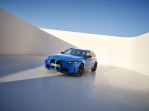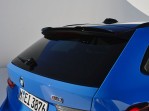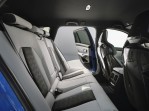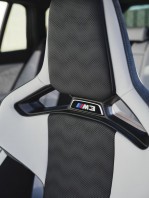Body style: Wagon (station wagon, estate, combi, touring)
Segment: Compact
Infotainment: ![]() Apple CarPlay
Apple CarPlay ![]() Android Auto
Android Auto
Production years: 2024
 49 Photos
49 PhotosBMW revealed the M3 Competition Touring in the summer of 2024 as a go-fast station wagon vehicle that could challenge some supercars and beat them around a track.
The German automaker created the most successful model in touring car racing in automotive history, the 1986 E30 M3. But that car was available only as a two-door affair, either as a coupe or as a convertible. Later, the automaker added the sedan to the range. The first generation of the M3 station wagon, or Touring as BMW named them, appeared on the market in 2022, and customers were thrilled. It was an excellent mix between a family vehicle and a sports car. After all, it sent over 500 ponies to the wheels and was able to carry a lot in its large trunk. But then, above the M3, the automaker introduced the Competition versions of them, featuring more potent engines and an even more aggressive look. In the summer of 2024, the automaker launched the M3 Competition Touring. This vehicle could threaten a sports car on a track and still carry a family around town for shopping. Sure, it wasn’t the most fuel-efficient grocery-getter around, but it could do that if needed, albeit its favorite job was for school runs. Especially runs.
At the front, the 2025 BMW M3 Competition Touring featured the same vertical-mounted kidney grille that outraged most of the brand’s fans. These were flanked by swept-back LED headlights sporting yellow daytime running lights instead of white like the rest of the 3 Series range. The lower grille had angular-shaped side scoops that flanked the tall nostrils-like grille. In addition, the hood featured two longitudinal power domes that were visible from the front. These were extended onto the upper area of the bumper and sported the brand’s badge between the two humps.
From its profile, the short front overhang and the long engine bay that could host an inline-six underneath it were classic characteristics of the M3. The car came fitted with 19-inch front wheels at the front and 20-inch at the back, wrapped in fat tires. BMW added sculptured wheel arches and extended side sills that created a powerful image for the vehicle, leaving no doubt about the car’s performance. The greenhouse was extended beyond the rear seats, over the trunk, following a slightly sloped-down shape. Finally, at the back, BMW’s design studio created a raked forward tailgate adorned by a wide roof spoiler at its upper side. On the lower side, the automaker placed a broad diffuser that integrated a four-exhaust system, with twin pipes mounted on each side.
Inside, the car had to provide comfort and a sporty ambiance. Its standard high-bolstered bucket seats with integrated headrests had thick cushions to make their occupants feel comfortable on long travels. The automaker also offered an option for carbon fiber seats with slimmer cushions, which were mostly adequate for those looking to use the vehicle at its maximum potential around a track. Fronting the driver was a redesigned dashboard featuring ambient color inserts and a curved piece of glass that covered the 12.3” display for the instrument panel and the 14.9” touchscreen for the infotainment system. Between the front occupants, the automaker added a center console that housed the gear selector and several buttons that controlled transmission and other essential functions of the car, including the controller for the iDrive infotainment unit. At the same time, in the back, the split-folding (40/20/40) bench seat could expand and increase the trunk’s space from a decent 500 liters (17.65 cu-ft) to a maximum of 1,510 liters (53.3 cu-ft).
Under the hood was the same S58 three-liter turbocharged M-specific engine. In the M3 Competition version, this could send 530 PS (523 hp) in all corners via an eight-speed automatic transmission. The driver could also opt to send all the oomph to the rear wheels only. Furthermore, the adaptive suspension and the braking system were tuned for this high-performance sports sedan, and a carbon ceramic braking system fitted with yellow monobloc calipers was available as an option.
BMW M3 Touring 2024
- Competition M xDrive 8AT AWD (530 HP)
BMW M3 Touring
Competition M xDrive 8AT AWD (530 HP)
ENGINE SPECS - Competition M xDrive 8AT AWD (530 HP) | |
|---|---|
| Cylinders: | L6 |
| Displacement: | 2993 cm3 |
| Power: | 389.8 KW @ 6250 RPM 530 HP @ 6250 RPM 523 BHP @ 6250 RPM |
| Torque: | 479 lb-ft @ 2750-5730 RPM 650 Nm @ 2750-5730 RPM |
| Fuel System: | Turbocharged Direct Injection |
| Fuel: | Gasoline |
| Fuel capacity: | 15.6 gallons (59.1 L) |
PERFORMANCE SPECS | |
|---|---|
| Top Speed: | 155 mph (249 km/h) |
| Acceleration 0-62 Mph (0-100 kph): | 3.6 s |
TRANSMISSION SPECS | |
|---|---|
| Drive Type: | All Wheel Drive |
| Gearbox: | 8-speed automatic M Steptronic with Drivelogic |
BRAKES SPECS | |
|---|---|
| Front: | Ventilated Discs |
| Rear: | Ventilated Discs |
TIRES SPECS | |
|---|---|
| Tire Size: | 275/35 ZR19 100Y XL // 285/30 ZR20 99Y XL |
DIMENSIONS | |
|---|---|
| Length: | 189 in (4801 mm) |
| Width: | 74.9 in (1902 mm) |
| Height: | 56.9 in (1445 mm) |
| Front/rear Track: | 63.7/63.2 in (1,618/1,605 mm) |
| Wheelbase: | 112.5 in (2858 mm) |
| Ground Clearance: | 4.8 in (122 mm) |
| Cargo Volume: | 17.7 cuFT (501 L) |
| Aerodynamics (Cd): | 0.36 |
| Turning circle: | 41.3 ft (12.6 m) |
WEIGHT SPECS | |
|---|---|
| Unladen Weight: | 4112 lbs (1865 kg) |
| Gross Weight Limit: | 5225 lbs (2370 kg) |
FUEL ECONOMY (WLTP) | |
|---|---|
| Combined: | 22.6 mpg US (10.4 L/100Km) |
| CO2 Emissions (Combined): | 235 g/km |
















































